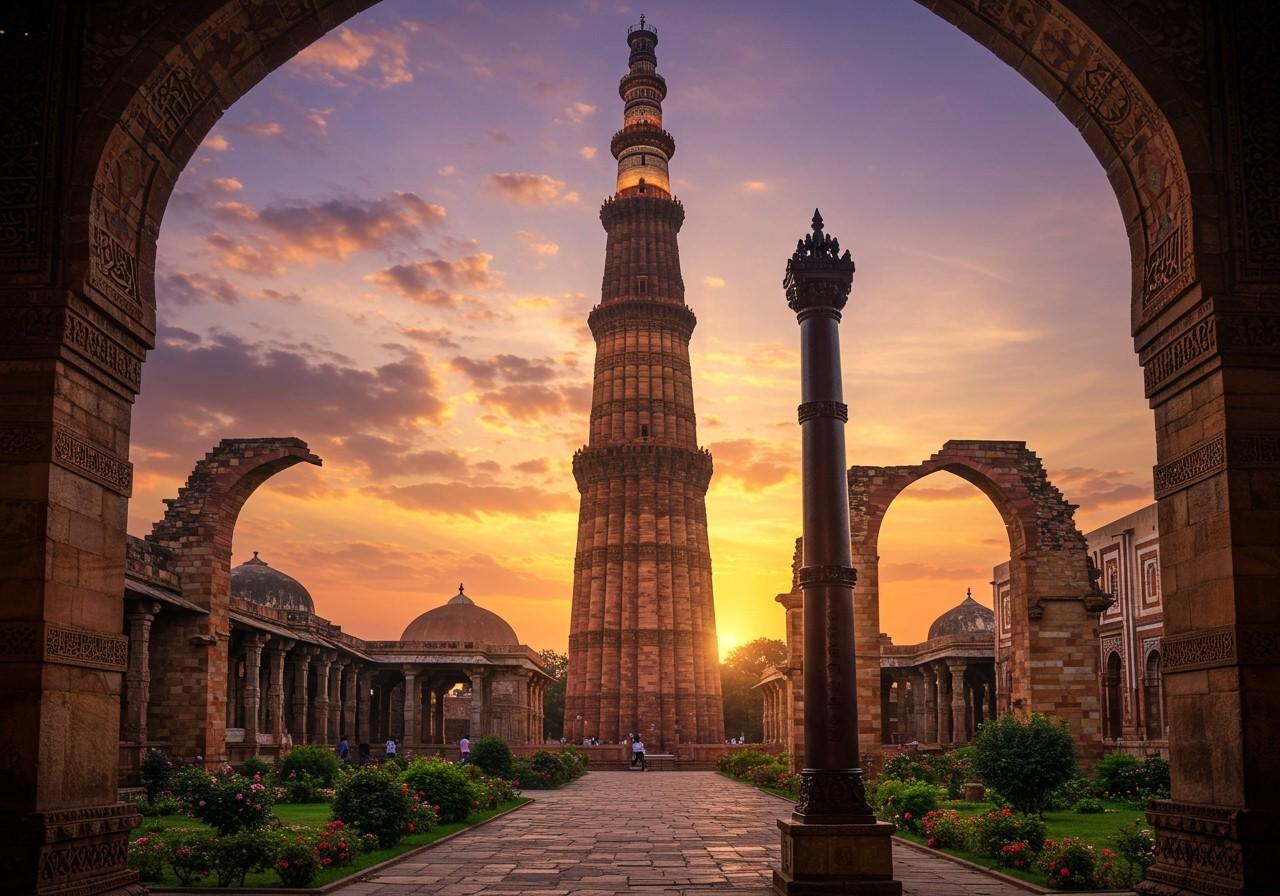
The Qutb Minar Complex, located in Mehrauli, Delhi, is a UNESCO World Heritage Site and a captivating blend of history, architecture, and culture. This magnificent monument, the tallest brick minaret globally at 72.5 meters, offers a glimpse into India’s rich past and attracts visitors eager to connect with their heritage.
A Walk Through Time: The History of Qutb Minar
Construction of the Qutb Minar began in 1199 AD under the reign of Qutb ud-Din Aibak, the first Sultan of Delhi, after his victory over the last Hindu kingdom in Delhi. Built upon the ruins of Lal Kot, the citadel of Dhillika, the minar’s completion is attributed to Aibak’s successor, Iltutmish. In the 14th century, Firoz Shah Tughlaq renovated the structure, replacing a damaged top story and adding another. The minar’s name is believed to be derived either from Qutb-ud-din Aibak himself or from Khwaja Qutbuddin Bakhtiar Kaki, a revered 13th-century Sufi saint.
Architectural Splendor: A Fusion of Styles
The Qutb Minar showcases exquisite Indo-Islamic architecture, blending influences from local Indian temples with Islamic principles. Constructed from red and buff sandstone, the minaret’s five distinct stories taper gracefully as they ascend, each adorned with projecting balconies. The walls are embellished with intricate Arabic and Nagari inscriptions. Within the complex, the Quwwat-ul-Islam Mosque stands as a testament to this architectural fusion, built using materials from demolished Hindu and Jain temples. The complex also houses the remarkable Iron Pillar, a metallurgical marvel resistant to corrosion for over a millennium. Other notable structures include the Alai Darwaza, the tomb of Iltutmish, and the Alai Minar, all remnants of the Delhi Sultanate period.
Cultural Significance and Preservation
The Qutb Minar Complex holds immense cultural significance, symbolizing a convergence of history and architectural ingenuity from the Delhi Sultanate era. Its UNESCO World Heritage status underscores its global recognition. The complex serves as an educational site, offering insights into the historical, religious, and cultural dynamics of medieval India. Ongoing preservation efforts strive to protect this historical treasure from the pressures of urban development, ensuring its integrity for generations to come.
Planning Your Visit: Essential Information
To fully experience the Qutb Minar Complex, consider these practical details:
- Opening Hours: The complex is generally open from sunrise to sunset (approximately 7:00 AM to 5:00 PM). Some sources suggest extended hours or nighttime illumination from 8:00 PM to 10:00 PM. Check for updated information before your visit.
- Entry Fee: Entry fees vary. Indian citizens typically pay between ₹35 and ₹40 (some sources mention ₹10), while foreign tourists may pay between ₹550 and ₹600 (some sources mention ₹250 or ₹500). Children below 15 years of age generally enjoy free entry.
- Best Time to Visit: Early morning visits are recommended to avoid large crowds and enjoy a more serene experience.
Enhance your visit with guided tours or audio guides for a deeper understanding of the site’s history. Don’t miss the opportunity to capture the intricate stone carvings and the majestic minaret through photography. Explore nearby attractions like the Mehrauli Archaeological Park and the Lotus Temple for a more comprehensive historical and cultural experience. Remember to dress respectfully and maintain the cleanliness of this significant cultural site.
Poojn.in: Supporting Your Cultural Exploration
At Poojn.in, we understand the importance of connecting with your spiritual side while exploring India’s rich cultural heritage. We offer a variety of products to enhance your experience:
- Prayer Items for Travel: Carry your devotion with you with our compact travel prayer kits, portable brass diyas like these, and small packets of sacred items like alta.
- Protection Items: Find solace and protection with traditional amulets, blessed threads (kalava/mauli), and travel packs of sacred ash (vibhuti).
- Meditation Supplies: Enhance your meditative practices with prayer beads (mala), meditation cushions like this asan, and copper water bottles for storing holy water.
Visit Poojn.in to explore our complete collection of authentic puja and spiritual items. Our customer service team is ready to assist you in choosing the perfect items for your cultural journeys. All products are certified authentic and sourced from trusted suppliers. Secure packaging and pan-India delivery ensure your sacred items reach you safely.
Conclusion: A Timeless Legacy
The Qutb Minar Complex stands as a beacon of India’s rich history and cultural harmony. It invites us to appreciate the past while embracing the present. Whether you are captivated by its architectural beauty or the stories embedded within its stones, the Qutb Minar Complex offers a profound journey through time. As you explore its grounds, may you feel the echoes of a vibrant past and carry forward a renewed admiration for the legacy it preserves.


